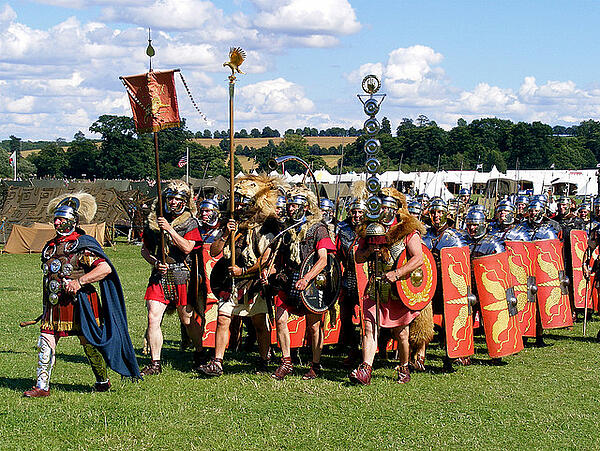Warfare in the Roman Empire
The Roman army and its warfare was viewed as being the most advanced of the time. Rome’s soldiers were the creators of the Roman Empire (a large part of Western Europe) and its country benefited from the wealth that was brought back by the army’s conquered territories.
The Roman army developed warfare strategies and techniques that flowed from a tough training scheme. Every new recruit to the army became very fit and disciplined - training was as equally harsh, as were punishments for failure. New recruits were always made to be in front of the experienced soldiers. This was for three particular reasons - the new soldiers could take courage in the fact that trained soldiers who were used to battles were behind them, and if their confidence suddenly vanished, they would be stopped from running away. Being at the front also meant you were most likely to be killed sooner, which was not a great loss for the army if the soldiers were new and inexperienced compared to their best legionaries.

The army’s most important fighting unit was the legion ordered by the legatus, which held between 5,000 - 6,000 legionnaires.
The Romans had a special technique of attacking their opponents - a legionnaire would run forward and throw their pila at the enemy. This was intended to cause distraction so the legionnaires could then move in for closer fighting with their swords or a gladius. Each successful attack made resulted from carefully constructed planning and practice.
The army also used cavalry to support the legionnaires. Cavalry’s purposes were mainly to attack an enemy line on the flanks and pursue a fleeing enemy.
Part-time soldiers known as auxiliaries were also used to assist the legionnaires. They were sometimes recruited from areas that the Romans were attempting to capture. However they were not fully trained soldiers and were required to fire at the enemy whilst the legionnaires attacked.
Weaponry for the Roman army was designed to protect the soldiers but also smash into defensive walls or reinforcements. Battering rams and siege towers were additionally used for this - siege towers enabled the Romans to gain fort access by removing the obstacle of a high wall. The coverings of battering rams had a wood and animal hide material which was flammable but able to prevent arrows.
Early versions of large catapults were produced (onagers) to hurl large stone boulders to smash down walls. Catapults were also used to fire iron bolts towards enemy lines.
Naturally these techniques and methods all required thorough training, which centurions were responsible for. Each needed to make sure his century had the skills and stamina to fight well, or risk being ‘decimated’ - if a century did not perform well they would have to stand in line whilst every tenth man was taken out and killed.
See also: The Roman Army
MLA Citation/Reference
"Warfare in the Roman Empire". HistoryLearning.com. 2026. Web.
